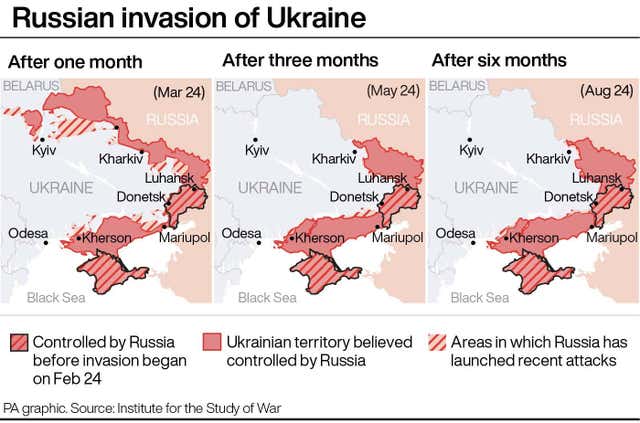IAEA seeks to visit Zaporizhzhia nuclear power plant amid concerns
Fire damage to a transmission line at Europe’s largest nuclear plant caused a blackout across the region and heightened fears of a catastrophe.

A team from the UN’s International Atomic Energy Agency (IAEA) is expected to visit the Russian-occupied Zaporizhzhia nuclear plant in Ukraine soon but more shelling was reported in the area overnight.
The visit comes after the plant was temporarily knocked offline, fuelling fears of a catastrophe in a nation still haunted by the 1986 Chernobyl disaster.
There were conflicting reports on Friday on the extent of the damage to a transmission line at the complex – Europe’s largest nuclear plant – that caused a blackout across the region on Thursday.
It was not immediately clear whether the damaged line carried outgoing electricity or incoming power that is needed for the reactors’ vital cooling systems.

Russia-installed officials in the Zaporizhzhia region have blamed Ukraine for the fire.
They said on Friday that the plant was functioning normally but that because of the problem, the plant was only supplying electricity to Russia-controlled areas and not the rest of Ukraine.
Ukrenergo, Ukraine’s electricity transmission system operator, however, reported on Friday that the two main power lines supplying the Zaporizhzhia plant with electricity that were damaged by the Russian shelling have resumed operation.
“Thanks to this, a stable power supply and safe operation of nuclear waste storage facilities and other important facilities located at the ZNPP site were ensured,” Ukrenergo reported on Telegram.
The statement added that the company’s repair teams will soon complete the restoration of another main line, further boosting the safety of the power plant.
Ukraine’s nuclear power plant operator, Energoatom, said on Friday morning that all of the plant’s power units were still disconnected from the power grid and repair work was under way.
But by 2pm it reported that the plant had been reconnected to the power grid and was producing electricity “for Ukraine’s needs”.

Fighting near the nuclear plant has sparked fears of a nuclear disaster that could affect both the area around that plant and much wider in Europe, just like the Chernobyl accident in 1986.
The atomic agency’s head, Rafael Mariano Grossi, said on Thursday he hopes to send a team to the plant within days.
Negotiations over how the team would access the plant are complicated but advancing, he said on France-24 television.
Concerns about the plant have reverberated across Europe.
“There is a worry and a big concern about nuclear safety. And that is why, since last March, I have been deeply engaged with the director-general of the International Atomic Energy Agency to do everything to protect initially Chernobyl and now Zaporizhzhia,” said French President Emmanuel Macron.
Mr Macron insisted that the “war shouldn’t, under any circumstances, undermine the nuclear safety of the country, the region and the rest of us”.
He added that both Ukraine and the Russians have pledged security guarantees for the IAEA mission, which he said should take place “very quickly”.

“Civilian nuclear power must not be an instrument of war and therefore the sovereignty of states must be respected in regard of nuclear installations.”
Lana Zerkal, an adviser to Ukraine’s energy minister, told Ukrainian media on Thursday evening that logistical issues are being worked out for the IAEA team to come to the Zaporizhzhia plant, which has been occupied by Russian forces and run by Ukrainian workers since the early days of the six-month-old war.
Ms Zerkal accused Russia of trying to sabotage the visit.
Ukraine has alleged that Russia is essentially holding the plant hostage, storing weapons there and launching attacks from around it.
Moscow, for its part, accuses Ukraine of recklessly firing on the facility.
“Despite the fact that the Russians agreed for the mission to travel through the territory of Ukraine, they are now artificially creating all the conditions for the mission not to reach the facility, given the situation around it,” she said, without elaborating.
Vladimir Rogov, a top official of the Kremlin-installed government of the Zaporizhzhia region, said on Friday that Russian authorities are prepared to ensure the safety of the IAEA mission when it arrives.

Spokesman Igor Konashenkov said “as a result (of the shelling), four munitions exploded near an oxygen-nitrogen generator”, and one more near a building.
Mr Konashenkov did not offer any details about the extent of damage the purported shelling caused.
Zaporizhzhia’s reactors are protected by reinforced concrete containment domes but fears remain of what could happen if the fighting intensified.
Dnipropetrovsk governor Valentyn Reznichenko said shelling in the city of Nikopol, which is across the Dnieper River from the Zaporizhzhia plant, damaged 10 houses, a school and a healthcare facility, causing no casualties.
A power line has also been cut, leaving up to 1,000 residents without electricity, he added.
Nikopol has been under nearly constant Russian shelling since July 12, with eight people killed, 850 buildings damaged and more than half the population of 100,000 fleeing the city.

The IAEA said Ukraine informed it that the reactors’ emergency protection systems were triggered, and all safety systems remained operational.
The three regular transmission lines at the plant are out of service because of previous war damage.
Ukraine cannot simply shut down its nuclear plants during the war because it is heavily reliant on them.
Its 15 reactors at four stations provide about half of the country’s electricity.
Elsewhere, two people were killed and six more injured over the past 24 hours in the eastern Donetsk region, governor Pavlo Kyrylenko said on Friday.
In the north-eastern Sumy region, on the border with Russia, more than 100 munitions were fired over the past 24 hours, burning down a house, governor Dmytro Zhyvytsky said.
One person was killed and another sustained injuries in overnight shelling of the north-eastern Kharkiv region, governor Oleh Syniehubov reported.





